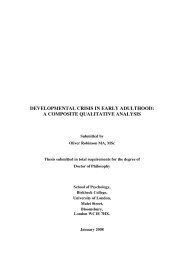University of Greenwich Strategic Plan 2012-17, 'Making
University of Greenwich Strategic Plan 2012-17, 'Making
University of Greenwich Strategic Plan 2012-17, 'Making
Create successful ePaper yourself
Turn your PDF publications into a flip-book with our unique Google optimized e-Paper software.
Identity and inspiration<br />
“A seat <strong>of</strong> learning and<br />
intellectual enquiry,<br />
exploration and discovery,<br />
it resonates with echoes<br />
<strong>of</strong> great characters and<br />
stirring national events.”<br />
Clive Aslet (1999) The Story <strong>of</strong><br />
<strong>Greenwich</strong>, Fourth Estate, London<br />
The <strong>University</strong> <strong>of</strong> <strong>Greenwich</strong> takes its name from the<br />
Royal Borough <strong>of</strong> <strong>Greenwich</strong> in London. <strong>Greenwich</strong> has<br />
a long and a rich history which forms the backdrop and<br />
inspiration for today’s university. It is here in the 15th<br />
and 16th centuries that Henry VIII and his daughters<br />
Mary I and Elizabeth I were born, and where Queen<br />
Mary II founded the Royal Hospital for Seamen, later the<br />
Royal Naval College and now campus buildings <strong>of</strong> the<br />
university.<br />
These buildings were designed at the end <strong>of</strong> the <strong>17</strong>th<br />
century by Sir Christopher Wren, one <strong>of</strong> Britain’s greatest<br />
architects, and the work was overseen by Nicholas<br />
Hawksmoor and Sir John Vanbrugh, both towering<br />
fi gures in their fi eld. Near to the <strong>Greenwich</strong> Campus, the<br />
Millennium Dome (now the O2) continues the tradition <strong>of</strong><br />
innovative architectural design up to the present day.<br />
A common maritime heritage connects the campuses<br />
at <strong>Greenwich</strong> and Medway. The university hinterland<br />
has played an important role in the rise <strong>of</strong> Britain as a<br />
dominant maritime force. Henry VIII founded the dockyards<br />
in Chatham, which led to the Royal Naval barracks being<br />
located there in buildings now occupied by the university.<br />
<strong>Greenwich</strong> is also the centre <strong>of</strong> space and time, where<br />
east meets west. Scientists and astronomers, including<br />
John Flamsteed and Edmund Halley, advanced scientifi c<br />
understanding from their positions as Astronomer Royal.<br />
The Royal Observatory holds John Harrison’s clocks,<br />
which were used to fi x the longitude <strong>of</strong> ships at sea, thus<br />
transforming marine navigation and enhancing Britain as a<br />
major sea power. Additionally, the area has a strong literary<br />
past: the writings <strong>of</strong> Samuel Pepys, Dr Samuel Johnson<br />
and Charles Dickens draw on their experiences <strong>of</strong> living in<br />
and visiting <strong>Greenwich</strong> and the Medway Towns.<br />
<strong>Greenwich</strong> and the surrounding region have played a key<br />
role in the emergence <strong>of</strong> Britain as an industrial power. For<br />
hundreds <strong>of</strong> years, local companies employed engineers<br />
and skilled tradesmen on which the capital depended.<br />
Today, it is a contemporary industrial and commercial<br />
region with high skills and high-value companies. The<br />
modern university draws inspiration from hundreds <strong>of</strong> years<br />
<strong>of</strong> local insight, ingenuity and innovation to work for the<br />
future – imagining possibilities, investigating uncertainties<br />
and identifying new challenges.<br />
3

















